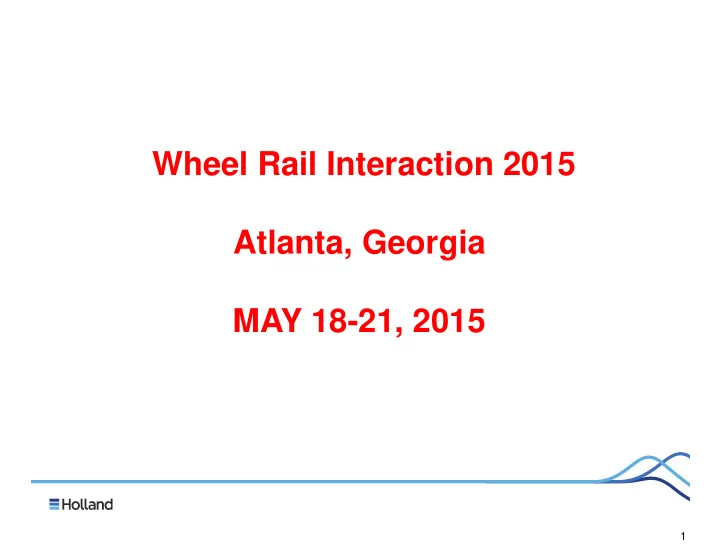

Wheel Rail Interaction 2015 Atlanta, Georgia MAY 18-21, 2015 1
Introduction • Railroads strive to maximize performance • Increased axle loads • Rail grinding • Lubrication • Wheel grinding • Rail life exceed 2,500 MGT and is projected to reach 5,700 MGT • Rail life is beginning to exceed the life of welds • Fatigue defects are becoming prominent • Options are being researched and implemented that will be able to extend rail/weld life 2 2
AAR initiates Heavy Axle Load (HAL) Research Program in 1988 • Guidance to NA RR industry on increasing axle loads • Determine most economic payload consistent with safety • Research showed • Technically feasible • Economically desirable • Technology able to mitigate adverse effects • 1991 • Industry accepts 286k GVW cars in interchange service • 2010 • 100% of coal traffic • 30% of general freight • 2013 • 90% of equipment acquired is rated for 286k GVW Introduction of Heavy Axle Loads by the North American Rail Industry by Carl D. Martland 3
Extent of HAL Implementation in 2012 (Commodities with an average of more than 104 tons/load on at least two Class I railroads) Iron Crushed Sand Hydraulic Corn Wheat Ore Coal Stone Gravel Cement BNSF 106.1 107.3 105.6 119.2 106.7 101.5 106.5 CSX 105.0 104.6 106.2 113.9 101.3 99.0 108.5 GTW 100.8 103.8 78.3 117.5 84.9 103.0 111.5 KCS 103.0 102.4 120.2 110.1 110.2 104.0 NS 104.4 102.4 94.7 111.9 103.8 101.7 107.0 SOO 100.1 100.8 118.7 106.2 107.7 UP 106.9 104.4 97.4 118.3 104.6 104.3 107.2 Average 104.8 105.1 86.1 116.7 102.4 102.9 107.3 % Implmt 0 ‐ 40% 0 ‐ 40% 0 ‐ 50% 90 ‐ 100% 0 ‐ 20% 0 ‐ 25% 20 ‐ 60% Source of Data: STB Quarterly Report of Freight Commodity Statistics, Third Quarter 2012 . 4
Rail Improvements • Rail is getting longer • 1831 – 16 foot lengths • 1880 – 39 foot lengths • 1940 – 78 foot lengths • 1988 – 80 foot lengths • 2002 – 480 foot lengths • Rail is getting harder and stronger • Tensile Strengths at 200,000psi • Hardness at 430 HB 5 5
Different Types of Defects are Becoming Prominent • Fatigue related defects • Reverse TDs • SSC – Shelling, Spalling & Cracking 6 6
One Class I’s Problem 7 7
Track Issue Caused by HAL 8
Rail/Weld Issue Caused by HAL 9
Rail/Weld Issue 10
SSC – Shelling, Spalling, Cracking 11
High Stresses Generated at Wheel/Rail Contact 12 12
Contact Patch Can Not Bridge Softened Zones of Weld 13 13
Weld Hardness Profile 14
Spherodized Soft Zones • Rail steel has a hard pearlitic microstructure • The weld zone becomes austenitic +1300 degrees F • Moving away from the weld, the maximum rail temperature has never reached a temperature high enough for the material to re-austenitize. • Soft zones are caused by time at temperature in locations where the rail has remained pearlitic. The plates of pearlite become soft (annealed) rounded spheres. • There is no way to avoid this 15 15
Solution One Address the Weld Making Process 16 16
Weld Making Process Options • Reduce the size of the spherodized zones • Less heat input • Potential weld hardness issues • Potential high residual stress issues in the weld • Welding process changes • Reduce heat to a minimum while avoiding too high of a hardness or undesirable microstuctures • Slow down cooling in the web to mitigate residual stresses 17 17
Reduce the Spherodized Zones 18 18
Contact Patch Can Better Bridge the Softened Zones of the Weld 19 19
Solution Two Minimize the Population of Welds in Track 20 20
Benefit of Long Rail • Rail is traditionally 80 ft in length • Rail produced 480 ft in length requires fewer welds • Rail welds per mile 5280 / 480 = 11 • Rail welds per mile 5280 / 80 = 66 • 480 ft lengths require 17% of the welds per mile as 80 ft lengths 21
Railroads and Suppliers Working Together • Class I railroad • Rail Suppliers • Rail Welding Company 22
Long Rail in North America 23 23
Start with a Greenfield Site Port of Stockton 24
Method to Transport Rail to NA 25
LRC 480 26
Hold to Carry the Rail 27
View Around the Ship 28 28
Method to Load/Unload the Rail 29
Method to Bring the Rail to the Ship 30
Concept to Store/Weld the Rail 31
Facility to Store/Weld the Rail 32
Constructing the Facility 33 33
Train to Transport the Rail from the Ship to the Welding/Storage Facility 34
Rail Can go to Welding Feed Tables or in to Storage 35
Storage Facility 36
Welding Facility Layout 37 37
Welding Facility 38
Automatic Quench 39
Post Weld Heat Treat Station 40
PWHT to Reduce Residual Stresses 41 41
Lead Out Stands 42
In Conclusion • Heavy axle loads appear to be shortening the potential life of the rail • Technology and methods exist to address the rail issues caused by HAL • Railroads are looking for and implementing new technologies and methods to prolong the life of rail assets 43 43
Wheel Rail Interaction 2015 Atlanta, Georgia MAY 18-21, 2015 Questions Thank You 44
Recommend
More recommend